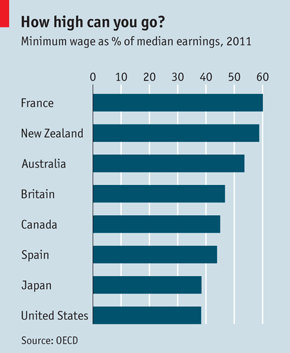 For decades, economists have argued over the effects of a minimum wage on employment. The old argument against it goes like this: any increase in the price of a good (in this case labor) will decrease demand for it. But policymakers have long seen the value in a minimum wage – after all, what good is a job if it doesn’t pay enough to buy groceries?
For decades, economists have argued over the effects of a minimum wage on employment. The old argument against it goes like this: any increase in the price of a good (in this case labor) will decrease demand for it. But policymakers have long seen the value in a minimum wage – after all, what good is a job if it doesn’t pay enough to buy groceries?
Now after several decades of advanced study by economists, empirical data is beginning to mount in support of the minimum wage. The new data show a minimum wage has little affect on low-wage employment, and suggests a higher wage floor (as exists in Britain, New Zealand, and other countries) decreses inequality “and may actually do some good.”
It’s worth noting the article also states “Britain’s small, regular changes may be easier for firms to absorb than America’s infrequent but hefty minimum-wage increases.” In 1998, Washington state pioneered small, regular minimum wage increases in the United States when voters approved a law to tie minimum wage to inflation. In 2013, Washington’s minimum wage will increase by 15 cents (1.7%) to $9.19/hour.
Read the full story from The Economist:
Minimum wage laws have a long history and enduring political appeal. New Zealand pioneered the first national pay floor in 1894. America’s federal minimum wage dates from 1938. Most countries now have a statutory pay floor—and the ranks are still swelling. Even Germany, one of the few big countries without, may at last introduce a national one. And in an era of budget austerity and widening inequality, the political temptation to prop up wages at the bottom by fiat may well grow.
Economists have tended to oppose minimum wages on the grounds that they reduce employment, hurting many of those they are supposed to help. Milton Friedman called them a form of discrimination against low-skilled workers. In standard models of competitive markets, anything that artificially raises the price of labour will curb demand for it, and the first to lose their jobs will be the least-skilled workers.
Yet economic theory allows for the possibility that wage floors can boost both employment and pay. If employers have monopsony power as buyers of labour and are able to set wages, for instance, they can keep pay below its competitive rate. Academic supporters of wage floors, mainly economists on the left, appealed to this logic. But most of their colleagues disagreed; and until about 1990, most empirical studies found that higher minimum wages cost jobs, particularly among young workers.
Then a pioneering case study by two noted labour economists, David Card and Alan Krueger, examined the response of fast-food restaurants to a rise in New Jersey’s state minimum wage. It found that this had actually increased employment. The paper spawned a flood of similar “case-study” research, a flurry of revisionist thinking and a heated academic debate. The most prominent critics of the new research were David Neumark of the University of California at Irvine and William Wascher of the Federal Reserve. They disputed Messrs Card and Krueger’s findings for New Jersey and argued that a comparison of different states over time showed that higher minimum wages hurt jobs.
More To Read
September 24, 2024
Oregon and Washington: Different Tax Codes and Very Different Ballot Fights about Taxes this November
Structural differences in Oregon and Washington’s tax codes create the backdrop for very different conversations about taxes and fairness this fall
September 10, 2024
Big Corporations Merge. Patients Pay The Bill
An old story with predictable results.
September 6, 2024
Tax Loopholes for Big Tech Are Costing Washington Families
Subsidies for big corporations in our tax code come at a cost for college students and their families
